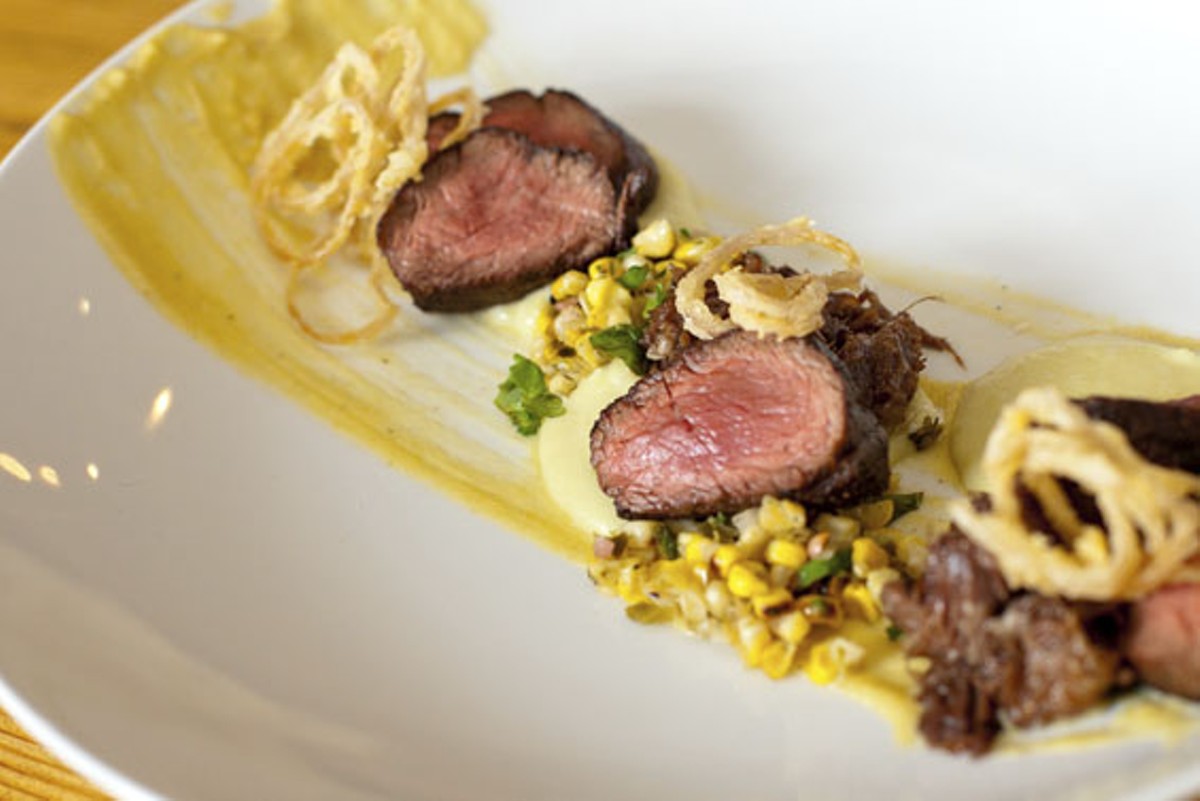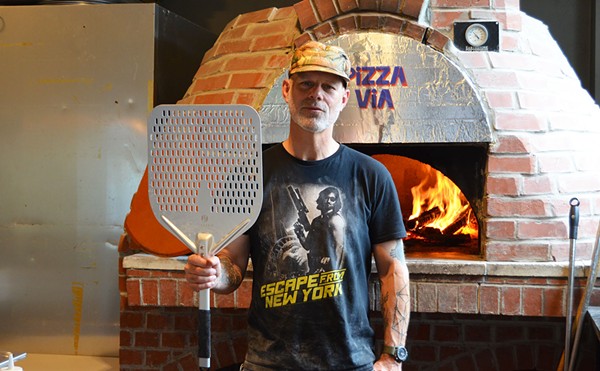When I reviewed Half & Half this past September, I liked the food at Mike Randolph's breakfast-and-lunch spot in Clayton, but the space itself seemed to lack a certain something. Or somethings. As in even one solitary piece of décor. Now, I could have suggested any number of ways to remedy the problem: a few framed prints; a large antique mirror; maybe a few bookshelves of bric-a-brac.
Opening a second, entirely different restaurant in the exact-same space never occurred to me.
Since late January, after lunch service every Tuesday through Saturday, the staff of Half & Half transforms the space into MEDIAnoche, a Mexican restaurant. They hang photographs of rustic Mexican scenes on the wall and place Mexican prayer candles on the tables. Half & Half's acclaimed coffee bar becomes a showcase for bartender T.S. Ferguson, who dramatically ignites the ingredients of his "Last Evening on Earth" cocktail (mezcal, cherry liqueur, lemon juice and cherries) before pouring the drink into a glass. It's an impressive performance, though I prefer the more subtle pleasures of the "MEDIAnoche" margarita (Espolón reposado tequila, Grand Marnier and fresh lime and orange juices) or the crisp and refreshing "Savage Detective" (tequila with sweet vermouth, Campari, Lillet and grapefruit juice).
MEDIAnoche's kitchen aspires to the approach Rick Bayless pioneered at his Chicago restaurants Topolobampo and Frontera Grill: authentic Mexican cuisine, taken seriously and presented inventively. Bayless got started in the mid-1980s. St. Louis got its first bite of auténtico, oh, about 30 years later, when Milagro Modern Mexican opened in Webster Groves. At MEDIAnoche you get free chips and salsa, but the salsas — you get two — are distinctive: One, with a base of adobo, is brick-red, thick and smoky; the other, made with roasted vegetables, wields a sharp chile note that slices through the deep, caramel sweetness.
When you order guacamole, a server prepares it tableside, scooping the flesh from two halved avocados and mashing it with cilantro, red onion, jalapeño and freshly squeezed lime juice inside a traditional stone molcajete. It's excellent guacamole, verifiably fresh, with the right balance of acid and spice to accent the rich avocado. (Only one server is assigned to guacamole duty, which means that if the restaurant is busy and several tables order it, you'll have to wait. It's worth it.)
Tender morsels of pig's head meat elevate a bowl of pozole, another appetizer. Guajillo chiles give the thick, hominy-studded broth a mild heat and a faint fruitlike sweetness, while raw radish slices add a welcome snap. MEDIAnoche distinguishes itself by the quality of its meats — the hog's head, pork belly, hanger steak, braised beef cheek (more on that in a moment).
In all, five appetizers are listed under the heading "Bocadillos." (A misnomer, technically: A bocadito is an appetizer; bocadillos are sandwiches. Both are diminutive forms of boca, the Spanish word for mouth.) Tacos get a category unto themselves, headed "Comida de la Calle" — i.e., street food — and come three to an order. These follow the taqueria template: soft corn tortillas filled with your choice of meat (or avocado, if you prefer meatless) and topped with cilantro and diced onion.
Pozole lovers can order the soup as an entrée-size portion. Several of the half-dozen other main courses ("Platos Fuertes") pair different preparations of the same meat. The "Dos Carnes" brings slices of hanger steak seared to order — I opted for medium-rare, and it arrived a glorious deep red in the center — and braised beef cheek so incredibly luscious that I'd happily eat a bowl of it all by itself with a spoon. The two meats are plated atop streaks of a feisty salsa borracha, with charred green onions and a gratin of poblano chiles. (The mild nature of poblanos made this a dish to be admired more than gushed over.)
Lomo de cerdo is pork tenderloin seasoned with a garlic mojo, grilled (without my having to ask) to an ideal medium temperature and served in an árbol chile sauce that has a piquant, lingering heat. Its accompanying salad of cucumber, sliced lengthwise very thin, and wedges of orange was a cooling antidote. The other pork component in this dish is a tamale stuffed with chorizo. This is the only dud I experiened at MEDIAnoche: The masa tasted fine but was too dry, and the kitchen was too chintzy with the chorizo.
As its name suggests, "Pato al Pastor" riffs on the classic al pastor taco. Here, in an arrangement much like the "Dos Carnes," duck breast grilled medium-rare and duck "carnitas" (imagine a richer, more deeply flavored duck confit) are served in a guajillo chile sauce, flanked by charred onion and grilled pineapple. This dish is supposed to come with corn tortillas for you to make tacos with, which our server forgot (twice), a rare misstep among generally good if unhurried service.
The non-meat entrées include huachinango, red snapper in a thin cucumber-lime escabeche studded with avocado and radish. The snapper was a beautiful piece of fish: the browned exterior yielding to moist flesh. I'd hoped to try the restaurant's lone vegetarian dish, a classed-up take on the classic chiles rellenos, but the kitchen had run out.
What holds MEDIAnoche back is its space: The dining room is small enough that when someone orders the guacamole, everyone in the restaurant hears (and feels) the service cart as it rumbles past; the kitchen is small enough that I imagine growing the menu would be prohibitively difficult. So while the place transcends the gimmick of being a restaurant inside another restaurant, you end up sensing that there's the ambition and potential of a completely independent restaurant here, straining to break out.






